Convair F-106 Delta Dart Video - Documentary
|
|
Airplane Picture: Convair F-106A Delta Dart of the 5th Fighter Interceptor Squadron
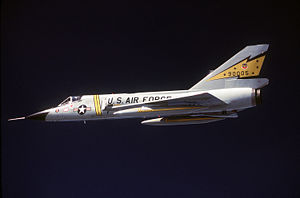
Role Interceptor
Manufacturer Convair
General Dynamics
First flight 26 December 1956
Introduced June 1959
Retired August 1988 (ANG)
Primary user United States Air Force
Number built 342 (2 prototypes, 277 F-106A, 63 F-106B)
Unit cost US$4.7 million[1]
Developed from F-102 Delta Dagger
The Convair F-106 Delta Dart was the primary all-weather interceptor aircraft for the United States Air Force from the 1960s through the 1980s. Designed as the so-called "Ultimate Interceptor", it has proven to be the last dedicated interceptor in USAF service to date. It was gradually retired during the 1980s, with the QF-106 drone conversions of the aircraft being used until 1998.[2]
Airplane Picture: A QF-106 Delta Dart shows its area ruled fuselage
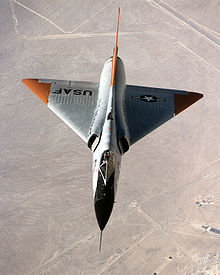
Design and development
The F-106 emerged from the USAF's 1954 interceptor program of the early 1950s as an advanced derivative of the F-102 Delta Dagger known as the F-102B, for which the United States Air Force placed an order for in November 1955. The aircraft featured so many modifications and design changes it became a new design in its own right, redesignated F-106 on 17 June 1956.[3]
The F-102's delta wing had to be redesigned with an area ruled fuselage to exceed supersonic speed in level flight. To exceed Mach 2, the largely new F-106 featured a more powerful J-75-P-17 afterburning turbojet with enlarged intake diameter to compensate for the increased airflow requirements and a variable geometry inlet duct, which allowed the aircraft improved performance particularly at supersonic speeds, as well as permitting a shorter inlet duct. The fuselage was cleaned up and simplified in many ways featuring a modified, slightly enlarged wing area and a redesigned vertical tail surface. The aircraft's exhaust nozzle featured a device known as an idle thrust reducer, which allowed taxiing without the jet blast blowing unsecured objects around, without adversely affecting performance at high thrust levels, including afterburners. The fuselage was also slightly longer than the F-102 Delta Dagger's.
Airplane Picture: F-106A Delta Darts from 5 FIS at CFB Moose Jaw in 1982
The first prototype F-106, an aerodynamic test bed, flew on 26 December 1956 from Edwards Air Force Base, with the second, fitted with a fuller set of equipment, following 26 February 1957.[4] Initial flight tests at the end of 1956 and beginning of 1957 were disappointing, with performance less than anticipated, while the engine and avionics proved unreliable. These problems, and the delays associated with them nearly led to the abandoning of the program,[4][5] but the Air Force decided to order 350 F-106s instead of the planned 1,000. After some minor redesign, the new aircraft, designated F-106A were delivered to 15 fighter interceptor squadrons along with the F-106B two-seat combat-capable trainer variant, starting in October 1959.[6]
On 15 December 1959, Major Joseph W. Rogers set a world speed record of 1,525.96 mph (2,455.79 km/h) in a Delta Dart at 40,500 ft (12,300 m).[7][8][9]
Airplane Picture: Convair F-106A (front) and F-106B of the 125th Fighter-Interceptor Group, Florida Air National Guard, over Jacksonville, Florida
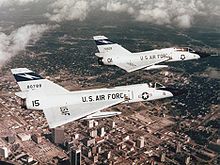
The F-106 was envisaged as specialized all-weather missile armed interceptor to shoot down bombers. It was complemented by other Century Series fighters for other roles such as daylight air superiority or fighter-bombing. To support its role, the F-106 was equipped with the Hughes MA-1 integrated fire-control system, which could be linked to the Semi-Automatic Ground Environment (SAGE) network for ground control interception (GCI) missions, allowing the aircraft to be steered by controllers. The MA-1 proved extremely troublesome and was eventually upgraded more than 60 times in service.[10] Similar to the F-102, it was designed without a gun, or provision for carrying bombs, but it carried its missiles in an internal weapons bay for clean supersonic flight. It was armed with four Hughes AIM-4 Falcon air-to-air missiles, along with a single GAR-11/AIM-26A Falcon nuclear-tipped semi-active radar (SAR)-homing missile (which detected reflected radar signals), or a 1.5 kiloton-warhead AIR-2 (MB-2) Genie air-to-air rocket intended to be fired into enemy bomber formations.[11] Like its predecessor the F-102 Delta Dagger, it could carry a drop tank under each wing.[12] Later fighters such as the Phantom and F-15 Eagle carried missiles recessed in the fuselage or externally, but stealth fighters would re-adopt the idea of carrying missiles or bombs internally for reduced radar signature.
Operational History
Airplane picture: F-106A Delta Dart from California ANG fires the AIR-2 Genie missile.
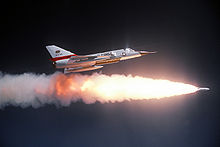
The F-106 served in the continental USA, Alaska, and Iceland, as well as brief periods in Germany and South Korea. The F-106 was the second highest sequentially numbered P/F- aircraft to enter service under the old number sequence (the F-111 was highest), before the system was reset under the 1962 United States Tri-Service aircraft designation system. In service, the F-106's official name, "Delta Dart," was rarely used, and the aircraft was universally known simply as the "Six."
Although contemplated for use in Vietnam the F-106 never saw combat nor was it exported to foreign users. Following the resolution of initial teething problems (in particular, an ejection seat that killed the first 12 pilots to eject from the aircraft)[13] its exceptional performance made it very popular with its pilots.
Airplane picture: An F-106A of the 87th FIS above Charleston AFB, SC in 1982.
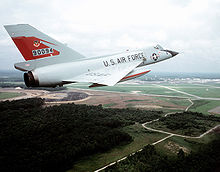
In an effort to standardize aircraft types, the USAF was directed to conduct Operation Highspeed, a fly-off competition between the USAF F-106A and the U.S. Navy F4H-1 (F-4B) Phantom, which was not only as capable as the F-106 as a missile-armed interceptor, but could also carry as large a bomb load as the F-105 fighter bomber.[14] The Phantom was the winner, but would first be tasked to escort and later replace the F-105 fighter-bomber in the late 1960s before replacing older interceptors in Air Defense Command in the 1970s.
The F-106 was progressively updated in service, with improved avionics, a modified wing featuring a noticeable conical camber, an infrared search and track system, streamlined supersonic wing tanks which provided virtually no degradation to overall aircraft performance, better instrumentation, and features like an inflight refuelling receptacle and an arresting hook for landing emergencies.[15]
Airplane picture: A Soviet Tu-95 intercepted by a 102nd FIW F-106A in 1982
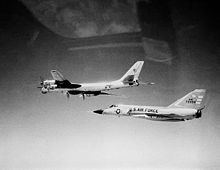
Air-to-air combat testing suggested the "Six" was a reasonable match for the F-4 Phantom II in a dogfight, with superior high-altitude turn performance and overall maneuverability (aided by the aircraft's lower wing loading). But the Phantom had better radar, an additional crewman to operate the radar, and could carry a load of up to four radar-guided Sparrow and four infrared Sidewinder missiles, while Falcon missiles proved a disappointment for dogfighting over Vietnam.[16] The F-4 had a higher thrust/weight ratio, superior climb performance, and better high speed/low-altitude maneuverability, and could be used as a fighter bomber. Air combat experience over Vietnam showed the need for increased pilot visibility and the utility of a built-in gun, which had been added to the "E" variant of USAF Phantoms. Some F-106As were upgraded in Project Six Shooter[17] in 1972, fitted with a new bubble canopy without the metal bracing along the top (which greatly improved pilot visibility), an optical gunsight, and provision for a single M61 Vulcan 20 mm cannon with 650 rounds of ammunition in the center weapons bay, replacing the AIM-26 Super Falcon or Genie.
The F-15A started replacing the F-106 in 1981, with the "Sixes" typically passed on to Air National Guard units. The F-106 remained in service in various USAF and ANG units until 1988.[2]
Starting in 1986, many of the surviving aircraft were converted into drones, designated QF-106A, and used for target practice. The last was destroyed in January 1998. The drones were still capable of being flown as manned aircraft, such as for ferrying to a test; during the test they were flown unmanned.[18] A handful of F-106s were retained by NASA for test purposes through 1998.
Variants
Airplane picture: A two-seat F-106B trainer variant of the New Jersey ANG.
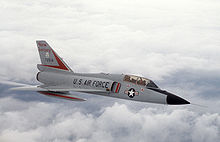
* F-102B : The original designation of the F-106A. Fitted with the MA-1 Integrated Fire Control System with SAGE datalink, J-75 afterburning turbojet, enlarged intake, variable geometry inlet ramps and shortened intake ducts, refined fuselage shape, modified wings and redesigned tailfin; tailpipe fitted with a device to reduce the tendency of the jet exhaust to blow unsecured objects around while taxiing, yet allowing virtually maximum performance at high thrust settings including afterburner. Performance was deemed unsatisfactory and modifications were made.
Weapons configurations (projected)
2 x AIM-4 Falcon, 2 x AIM-4 Falcon, and 2 x AIM-4 Falcon or
2 x AIM-4 Falcon, 2 x AIM-26 Super-Falcon, and 2 x AIM-4 Falcon or
2 x AIM-4 Falcon, 1 x AIM-26 Super-Falcon, 1 x AIM-4, and 2 x AIM-4 Falcon or
2 x AIM-4 Falcon, 1 x AIR-2A Genie, 2 x AIM-4 Falcon
Airplane picture: The QF-106 Delta Dart target drone.
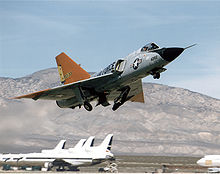
* F-106A : Modified F-106 with improved performance. Maximum speed at least Mach 2.5, with some estimates as high as Mach 2.85 in level flight. The aircraft was capable of low supersonic speeds without afterburner (but with a significant range penalty) and had a maximum altitude at least 57,000 ft. Many were fitted with a conically-cambered wing for improved takeoff, supersonic and high-altitude flight. To improve the aircraft's range the aircraft was fitted with two streamlined external supersonic tanks that still kept the aircraft capable of sustained roll rates of 100 degrees per second. Since these tanks produced virtually no significant performance degradation they were rarely jettisoned and were routinely carried around. After 1972, many F-106s were refitted with a new canopy featuring improved visibility, improved optic sights and provision for a gunpack in the center weapons bay.
Weapons configurations
2 x AIM-4 Falcon, 2 x AIM-4 Falcon, and 2x AIM-4 Falcon or
2 x AIM-4 Falcon, 2 x AIM-26 Super-Falcon, and 2 x AIM-4 Falcon or
2 x AIM-4 Falcon, 1 x AIM-26 Super-Falcon, 1 x AIM-4 Falcon, and 2 x AIM-4 Falcon or
2 x AIM-4 Falcon, 1 x AIR-2A or AIR-2B Genie, and 2 x AIM-4 Falcon
2 x AIM-4 Falcon, 1 x M61 gunpack with 650 rounds, and 2 x AIM-4 Falcon
* F-106B : Two-seat, combat-capable training version. Pilot and instructor are seated in tandem. Due to the extra seat, the fuselage is actually better area ruled; combined with a likely reduction in weight.[19]
Airplane picture: An F-106A of the Montana ANG viewed from the rear.
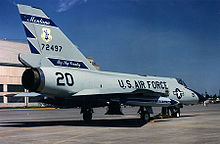
Weapons configurations same as F-106A.
* NF-106B : This designation was given to two F-106Bs used as test aircraft with NASA and associated research facilities from 1966 to 1991.[20]
F-106C : Unbuilt version. Aircraft was intended to have the AN/ASG-18 radar and fire control system fitted originally developed for the XF-108 Rapier.
For its time, it was the largest radar to ever be fitted to a fighter, actually requiring hydraulic actuators to turn the antenna. To accommodate this
larger radar system, the nose cone was longer and of greater diameter. The design featured an improved raised canopy design featuring better visibility,
canards and lengthened rectangular inlet ducts. The aircraft was to be capable of carrying one GAR-9/AIM-47A in its center bay and one AIM-26A in each
side bay. At one time, the US Air Force had considered acquiring 350 of these advanced interceptors, but the F-106C/D project was cancelled on 23 September
1958.[21]
* F-106D : Unbuilt two seat version of the F-106C.
* F-106X : Unbuilt version (early 1968). Would have been outfitted with canards and powered by a JT4B-22 turbojet. It was envisioned as an alternative
to the Lockheed YF-12, and was to have had a fire control system with "look-down, shoot-down" capability fed by a 40-inch radar dish.[8]
* F-106E : Unbuilt version. On 3 September 1968, Convair issued a proposal for an "improved" interceptor that was to be designated F-106E/F.
It was to be compatible with the upcoming airborne warning and control systems as well as with the "over-the-horizon" radar defense network.
The F-106E/F would have had a longer nose and a new and improved radar with a look-down/shoot-down tracking and missile launch capability. It would also
have had a two-way UHF voice and datalink radio. It would have been capable of launching both nuclear and non-nuclear missiles, including the AIM-26 Nuclear
Falcon and the AIM-47.[22]
* F-106F : Unbuilt two seat version of the F-106E.
Incidents
Airplane picture: F-106 no. 58-0787 on the ground after the pilot ejected.
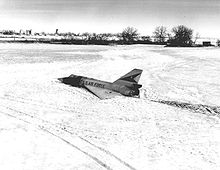
An F-106 of the 71st Fighter-Interceptor Squadron, piloted by Gary Faust, entered a flat spin over Montana on February 2, 1970. Faust followed procedures
and ejected from the aircraft. The resulting change of balance caused the aircraft to stabilize, and it landed wheels up in a snow-covered field, suffering
almost no damage. The aircraft was then sent back to base by rail, repaired and returned to service.[23]
Aircraft on display
A partial list of statically displayed F-106 Delta Darts, by model, museum or base, location, and serial number:[24]
F-106A
Airplane picture: One of the last two F-106s in active service, seen here in 1990 as a safety chase aircraft in the B-1B aircraft production acceptance flight test program.
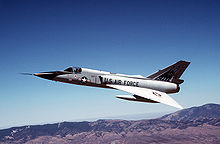
* Aerospace Museum of California, [[McClellan Airfield (former McClellan AFB), Sacramento, California, AF Ser. No. 59-0010 [25]
* Air Mobility Command Museum, Dover AFB, Delaware, AF Ser. No. 59-0023 [26]
* California ANG - 144th Fighter Wing, Fresno ANGB, California AF Ser. No. 59-0146
* Evergreen Aviation & Space Museum McMinnville, Oregon, AF Ser. No. 59-0137
* Florida ANG - 125th Fighter Wing, Jacksonville ANGB, Jacksonville International Airport, FL
* Florida ANG - 125th FW, Homestead ARB, Homestead, Florida, AF Ser. No. 57-0230
* Florida ANG - 125th FW, Camp Blanding Museum, Middleburg, Florida, AF Ser. No. 59-0105[27]
* Heritage Park, Holloman AFB, New Mexico
* Hill AFB Museum, Hill AFB, Utah, AF Ser. No. 58-0774[28]
* McChord Air Museum, McChord AFB, Washington, AF Ser. No. 56-0459 [29]
* Minot AFB, North Dakota, AF Ser. No. 56-0460 [30]
* Montana ANG - 120th Fighter Wing, Great Falls ANGB, Great Falls, Montana, AF Ser. No. 56-0069 [31]
* Museum of Aviation Robins AFB, Georgia, AF Ser. No. 59-0123 [32]
* National Museum of the United States Air Force, Wright-Patterson AFB, Dayton, Ohio, AF Ser. No. 58-0787 [33] (F-106 that landed itself with relatively
minor damage in a farmer's field after its pilot lost control and ejected) It last served with the 49th Fighter Squadron before being brought to the museum
in August 1986.[34]
* Peterson Air and Space Museum, Peterson AFB, Colorado Springs, Colorado, AF Ser. No. 59-0134[35]
* Pima Air & Space Museum, adjacent to Davis-Monthan AFB in Tucson, Arizona, AF Ser. No. 59-0003 [36]
* Tyndall Air Park, Tyndall AFB, Florida, AF Ser. No 59-0145 [37]
NF-106A
* Selfridge Military Air Museum, Selfridge ANGB, Michigan, AF Ser. No. 56-0451
F-106B
* Edwards AFB Century Circle, Edwards AFB, California, AF Ser. No. 59-0158
* Kelly Field Heritage Museum, Lackland AFB/Kelly Field (former Kelly AFB), Texas, AF Ser. No. 57-2533 [38]
* New Jersey ANG - 177th Fighter Wing, Atlantic City ANGB, Atlantic City, New Jersey, AF Ser. No. 57-2523
NF-106B
* Virginia Air and Space Center / Hampton History Center, Hampton, Virginia, AF Ser. No 57-2516 and NASA/FAA Registration N816NA[20][39][40]
Specifications (F-106A)
Orthographically projected diagram of the Convair F-106A Delta Dart.
Data from Quest for Performance[41]
General characteristics
Airplane picture: F-106 Drawing
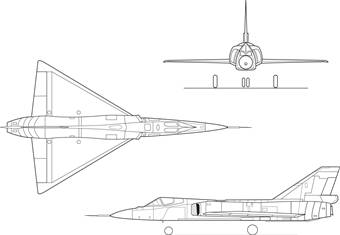
* Crew: 1
* Length: 70.7 ft (21.55 m)
* Wingspan: 38.25 ft (11.67 m)
* Height: 20.28 ft (6.18 m)
* Wing area: 661.5ft²/61.52m² (Original Wing) or 695 ft²/64.57m² (Conically-Cambered Wing) ()
* Airfoil: NACA 0004-65 mod root and tip
* Empty weight: 24,420 lb (11,077 kg)
* Loaded weight: 34,510 lb (15,670 kg)
* Powerplant: 1× Pratt & Whitney J75-17 afterburning turbojet, 24,500 lbf (109 kN)
* * Zero-lift drag coefficient: 0.0083
* Drag area: 5.8 ft² (0.54 m²)
* Aspect ratio: 2.10
Performance
* Maximum speed: Mach 2.3 (1,525 mph, 2,455 km/h)
* Range: 1,800 mi (1,600 nm, 2,900 km) combat
* Ferry range: 2,700 mi (2,300 nm, 4,300 km)
* Service ceiling: 57,000 ft (17,000 m)
* Rate of climb: 29,000 ft/min (150 m/s)
* Wing loading: 52 lb/ft² (255 kg/m²)
* Thrust/weight: 0.71
* Lift-to-drag ratio: 12.1
* Time to altitude: 6.9 min to 52,700 ft (16,065 m)
Armament
* Guns: 1× 20 mm (0.787 in) M61 Vulcan 6-barreled gatling cannon
* Missiles:
o 2× AIM-4F Falcon
o 2× AIM-4G Falcon
o 1× AIR-2A Genie nuclear rocket or AIM-26 Super Falcon missile, a capability replaced since 1972 with a gun pod
See also
Seal of the US Air Force.svg United States Air Force portal
* Century Series
Related development
* Convair XF-92
* Convair F-102 Delta Dagger
Comparable aircraft
* Avro Canada CF-105 Arrow
* Dassault Mirage III
* English Electric Lightning
* Mikoyan-Gurevich MiG-21/Chengdu J-7
* Saab 35 Draken
* Sukhoi Su-9/Su-11
* Sukhoi Su-15
References
Notes
1. ^ Knaack, Marcelle Size. Encyclopedia of US Air Force Aircraft and Missile Systems: Volume 1 Post-World War II Fighters 1945-1973. Washington, DC:
Office of Air Force History, 1978. ISBN 0-912799-59-5.
2. ^ a b Winchester 2006, p. 55.
3. ^ Pace 1991, p. 138.
4. ^ a b Peacock 1986, p.200.
5. ^ Wegg 1990, p.209.
6. ^ Green 1964, p. 138.
7. ^ Drendel 1980, p. 92.
8. ^ a b Donald 2003, p. 232.
9. ^ "U.S. Jet Sets 1,520.9-M.P.H. Speed Record", Oakland Tribune, 16 December 1959, p. 1.
10. ^ Baugher, Joe. Convair F-106A Delta Dart. Convair F-106A Delta Dart Retrieved: 26 February 2007.
11. ^ Winchester 2006, p.54.
12. ^ Taylor 1995, p. 93.
13. ^ Broughton 2007, p. 17. Note: Broughton commanded the 5th FIS when these fatalities occurred.
14. ^ National Museum of the U.S. Air Force
15. ^ Donald 2003, pp. 242, 246.
16. ^ Donald 2003, pp. 259–260.
17. ^ Donald 2003, p. 250.
18. ^ Donald 2003, pp. 270–271.
19. ^ It is uncertain if the F-106B was fitted with the modified Project Sharpshooter optic sights and gunpack provision.
20. ^ a b Baugher: NF-106B
21. ^ Baughers: F-106C/D Note: After the cancellation of the Avro Arrow, the Canadian government briefly considered purchasing the F-106C/D. After the
F-106C/D project was canceled, it acquired CF-101s, instead.
22. ^ Air To Combat: F-106C/D/E/F
23. ^ Curtiss, Tom. "58-0787 landed Pilot-less in a field in Montana." Mohawk Flyer, 10 March 1978. Retrieved: 10 March 2009.
24. ^ "AeroWeb list of F-106 Delta Darts on display in the US." aero-web.org. Retrieved: 10 October 2010.
25. ^ "A Brief History of Convair F-106A SN 59-0010." lanset.com. Retrieved: 10 October 2010.
26. ^ "59-023." 1000aircraftphotos.com. Retrieved: 10 October 2010.
27. ^ "59-0105." f-106deltadart.com. Retrieved: 10 October 2010.
28. ^ "Hill Air Force Base - F-106A Delta Dart." hill.af.mil. Retrieved: 10 October 2010.
29. ^ 56-459 aero-web.org. Retrieved: 10 October 2010.
30. ^ "56-460." aero-web.org. Retrieved: 10 October 2010.
31. ^ "59-069." aero-web.org. Retrieved: 10 October 2010.
32. ^ "59-123." aero-web.org. Retrieved: 10 October 2010.
33. ^ "58-0787." aero-web.org. Retrieved: 10 October 2010.
34. ^ "Convair F-106A Delta Dart." nationalmuseum.af.mil. Retrieved: 10 October 2010.
35. ^ "59-0134." airliners.net. Retrieved: 10 October 2010.
36. ^ "59-0003." aero-web.org. Retrieved: 10 October 2010.
37. ^ "59-145." aero-web.org. Retrieved: 10 October 2010.
38. ^ "57-2533." aero-web.org. Retrieved: 10 October 2010.
39. ^ "N816NA." aero-web.org. Retrieved: 10 October 2010.
40. ^ FAA N-number "Verification for N816NA." FAA. Retrieved: 10 October 2010.
41. ^ Loftin, L.K, Jr. "Quest for performance: The Evolution of Modern Aircraft." NASA SP-468. Retrieved: 22 April 2006.
Bibliography
* Broughton, Jack. Rupert Red Two: A Fighter Pilot's Life from Thunderbolts to Thunderchiefs. Osceola, Wisconsin: Zenith Press, 2007. ISBN 978-0-7603-3217-7
* Carson, Don and Lou Drendel. F-106 Delta Dart in Action. Carrollton, Texas: Squadron/Signal Publications, 1974. ISBN 0-89747-014-1.
* Donald, David. "Convair F-106 Delta Dart: The Ultimate Interceptor."Century Jets. London: AIRtime Publishing Inc, 2003. ISBN 1-880588-68-4.
* Drendel, Lou. Century Series in Color (Fighting Colors). Carrollton, Texas: Squadron/Signal Publications, 1980. ISBN 0-89747-097-4.
* Green, William. The World's Fighting Planes. London: Macdonald, 1964.
* Pace, Steve. X-Fighters: USAF Experimental and Prototype Fighters, XP-59 to YF-23. Osceola, Wisconsin: Motorbooks International, 1991. ISBN 0-87938-540-5.
* Peacock, Lindsay. "Delta Dart...Last of the Century Fighters". Air International, Vol. 31, No 4, October 1986, pp. 198–206, 217. Stamford,
UK: Fine Scroll.
* United States Air Force Museum Guidebook. Wright-Patterson AFB, Ohio: U.S. Air Force Foundation, 1975.
* Taylor, Michael J. H., ed. "Convair Delta Dart". Jane's American Fighting Aircraft of the 20th Century. New York: Modern Publishing, 1995.
ISBN 978-0792456278.
* Wegg, John. General Dynamic Aircraft and their Predecessors. London:Putnam, 1990. ISBN 0-85177-833-X.
* Winchester, Jim, ed. "Convair F-106 Delta Dart." Military Aircraft of the Cold War (The Aviation Factfile). London: Grange Books plc, 2006.
ISBN 1-84013-929-3.
Living Warbirds: The best warbirds DVD series.
Source: WikiPedia